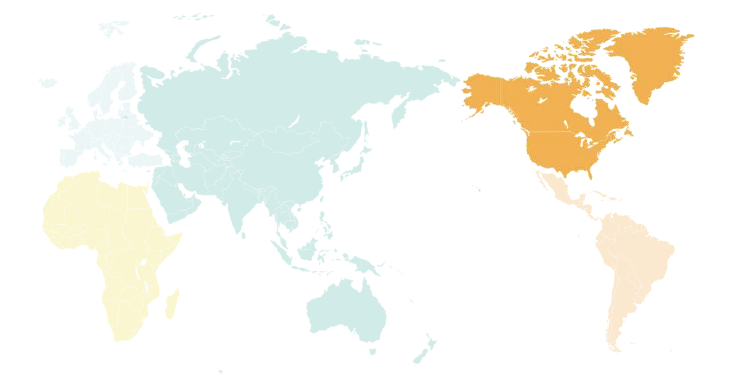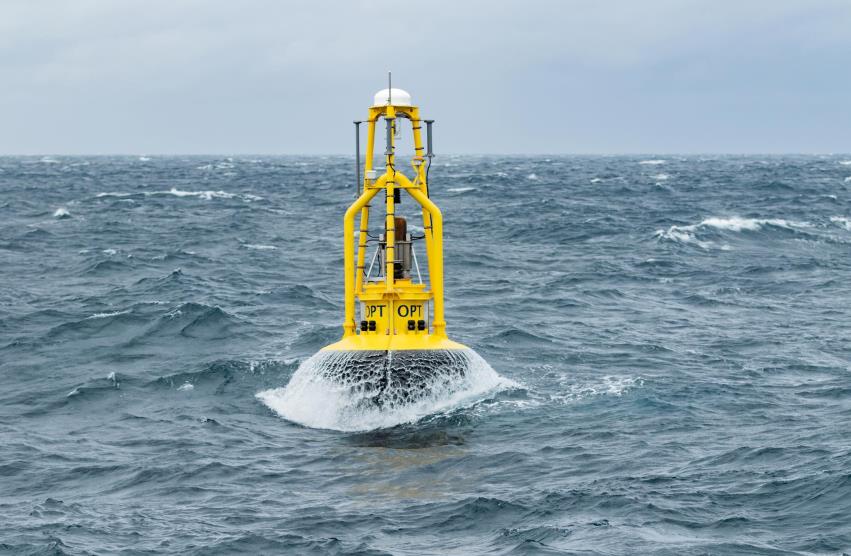Main Theme
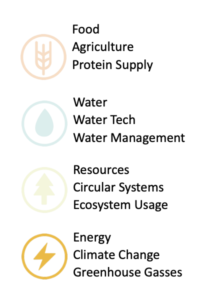
Sub-theme: Wave energy; renewable energy; marine innovation; Carbon Footprint; Carbon
Reduction; digitization; marine industry
Abstract
The Blue Economy refers to an economy that is motivated by the use and management of resources from the ocean. Currently, the Earth’s oceans experience increased pressures from over-exploitation, pollution and climate change, all of which change the chemical and biological makeup of this fragile environment. Thus, finding ways to use ocean resources that are sustainable and preserve ocean health are a win-win. Generating power from wave energy is one such proposal, that additionally allows for digitisation of the marine industry.
Since its beginnings in 1984, Ocean Power Technologies (OPT) has been providing services and consultation regarding wave energy and ocean operations that help service recipients reduce their carbon output. OPT’s most advanced iteration of wave generation devices is the PB3 PowerBouy, which is available to the various industries working off-shore and on-shore, they also supply Hybrid PowerBouys. In addition to ocean energy generation, OPT’s technology collects data that helps industries communicate effectively at sea and monitor their effects on the environment. Ocean Power Technologies’ PowerBuoy provides clean energy to short and long-term offshore operations, and are generating the power that is catalysing further innovations in the marine industry field.
Sustainable Development Goals Chart

Main Highlights
Problem
Need to shift away from non-renewable energy sources, for both grid generation as well as in ocean industries. Also, a need for more reliable data on offshore operations, which requires a reliable energy source.
Context
The ocean provides an opportunity for generating energy from wave power, which is one of the most powerful sources of energy on the planet. Wave power technology not only benefits the environment, but provides economic and scientific opportunities globally.
Solution
Ocean Power Technologies created the PowerBuoy, an off-shore generator and data collector, that emits almost no-carbon, while providing power and information to on and off-shore operations. It is a leap-forward in zero-carbon technology for wave energy as well as the digitisation of marine operations.
Impact Statement
Investing in wave energy include economic benefits, increased ocean and human health, increased ability for marine explorations, and reliable energy resources.

Renewable power generation by technology, 2000-2030. As shown in the graph above, ocean’s currently provide an almost non-existent amount of energy generation when compared to other renewable resources. There is much room for growth in this ocean energy sector.
Case Overview
Global energy production has increased exponentially over the last century, and the total energy supply (TES) still remains fully dependent on non-renewable resources: coal, oil, and gas. Since 1971, coal production has increased by 2.2 percent, natural gas production has increased by 2.8 percent, and oil production has increased by 1.2 percent. From 2018 to 2019, coal and natural gas production continued to increase, while oil production decreased by 0.3 percent. Coal remains the dominant energy source used globally, accounting for 40 percent of energy use. Renewable resources have negative effects on the oceans ecosystems and on human health, subsequently. Coal power plants produce many toxic heavy metals, such as selenium, mercury, arsenic, cadmium, thallium. Coal ash deposits from power generation create legacies of toxic waste. When coal is burned, some of these toxins also enter the atmosphere and deposit in waterways and the ocean. In 2014, for instance, exceedingly high levels of mercury were reported in global oceans (60,000 to 80,000 tons of mercury), levels that contribute to neurological and nervous system damage. Not only does this contribute to ocean acidification, this toxicity affects the health of humans as well as other species (i.e. mercury in fish we consume). In addition to polluting our oceans, non-renewable resources like oil, gas and coal contribute to carbon emissions and the warming of the Earth’s atmosphere. About 4.2 million people died prematurely from air pollution in 2016, with a disproportionate amount of those people coming from disadvantaged socioeconomic positions, which makes air pollution a matter of environmental justice, too. On the impact of pollution on human and planetary health, the Lancent remarks, “pollution is a planetary threat, and that its drivers, its dispersion, and its effects on health transcend local boundaries and demand a global response.” In order to achieve net-zero resource production, a massive jump in the use of renewable resources is necessary. Renewable, net-zero, ocean energy is a critical component for a future that promotes clean energy and human well-being. This will require increased research on ocean-based technologies, funding, and policy to encourage net-zero resource production.
Wave Energy
Wave energy has a surprisingly long history. The first patent for wave energy was given to Monsieur Girard in Paris, in 1799. This first attempt inspired the minds of inventors, and from 1855 to 1973 there were 340 attempts at wave energy in the UK alone. Over the years, interest in this topic has continued, albeit on the fringes of conventional energy generation. Significant contributions to the field were made by Yoshio Masuda (1925–2009), a Japanese navy commander and pioneer in wave energy technology, who worked on wave energy staring in 1940. Masuda developed one of the common designs for wave energy, the oscillating water column (OWC), which is a navigation buoy with a turbine. Some critiques of this design is that it is not practical for all coastal environments. In the 1970s during the oil crisis, wave energy had renewed interest, and one new design that derived from that era was the more efficient ‘Salter’s Duck.’ Other more contemporary wave energy devices include the ‘carpet converters‘ – currently being experimented with at UC Berkeley – and the overtopper.’
How wave technology works is relatively simple: as wind moves across the ocean’s surface, it creates waves, and when the waves interact with power generators, the motion produces electricity within the generator. This electricity can then be distributed to off or on-shore recipients. In the case of some modern devices (such as the Power Bouy as outlined below), a battery pack is charged using wave power. This battery pack then can send power to equipment located on the seabed or other on and off-shore recipients.
Various factors to consider in wave energy include the technology used; the location they are placed; and their purpose. Current designs for wave energy include: Oscillating Water Columns; Oscillating Body Converters; and Overtopping Converters. Location factors include: onshore; near shore; or offshore placements. The application of the technology includes: desalination; power generation; environmental protection (science); or a mixture of all three. Challenges include design as wave energy extracts energy from waves of all sizes that move in multiple directions, identifying the type of machine that can most-effectively do this work is a key goal, and why it can take years, if not decades of research to get the models right to work effectively in the marine environment.
The Boom of Wave Energy
The global wave energy market is projected to reach USD 107 million by 2025 from an estimated market size of USD 44 million in 2020 – due to advancements in efficiency of the technology as well as increasing ease of installation. Wave energy is also projected to be useful for desalination operations, which are increasingly being sought after to produce fresh water in water scarce zones. Europe is the largest and the fastest-growing wave energy market, followed by North America and Asia Pacific. Europe is currently leading in wave energy technology, due to the large number of companies working in this sector and the emphasis on R&D for wave energy converters. Currently, main global players in this field include: Eco Wave Power (Israel), Carnegie Clean Energy (Australia), SINN Power (Germany), CorPower (Sweden), Ocean Power Technology (US), and AMOG Consulting (Australia). Ocean Power Technology is the wave energy leader in North America. Globally, wave energy has the potential to provide up to 80,000 terawatt hours. This could power millions of homes, businesses, and operations. In the US, for instance, 50% of the U.S. population lives within 50 miles of the coast. Similarly in a country ocean-bound like Japan, dependent on fossil-fuels for energy, waves could be a huge boon for power generation and achieving sustainability targets.
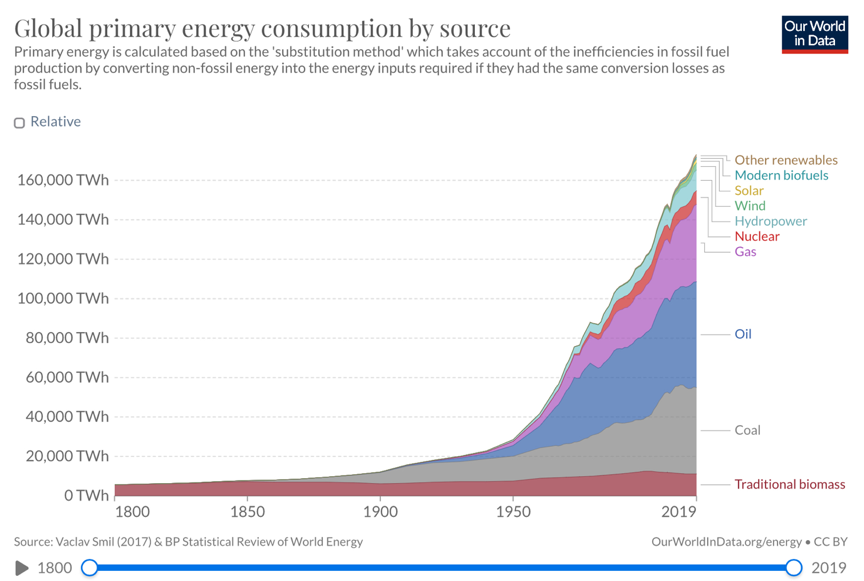
Global Primary Energy Consumption by Source, 1800-2019. From this graph we can see that ‘other renewables’ is just a fraction of the amount of energy produced and consumed. The majority of energy consumption remains in fossil-fuels.
Industry Leader: Ocean Power Technologies
Ocean Power Technologies’ PowerBuoy works to ‘energise ocean intelligence.’ Their wave technology achieves the goal of power generation while emitting little to no carbon. Their current model is a PB3 PowerBuoy, which acts as an Uninterruptable Power Supply (UPS) – constantly recharging itself by harvesting energy from the waves. This device is ocean-deployed, moored and floats over the point of use and can operate in any ocean depth over 20 meters and up to 3,000 meters (3 km). This buoy can be used for energy at location, or transported to shore. Another option by OPT is the Hybrid PowerBuoy, which is for at-sea operations, and is a mix of wave, solar, and generator power, that they market as being a low-to-zero emissions solution for ocean power. When they first started in 1984, OPT was oriented towards trying to find solutions to bring wave energy to the grid. Through the evolution of their brand, they now work primarily with offshore industries, scientific research, and territorial security, among others. They are filling a zero-carbon and data solutions gap for these industries that require consistent power, 24/7 full-scale data capabilities, and real-time communications.
In 2015, Ocean Power Technologies commercialized the PowerBuoy, making it available for scientific research, security and private offshore operations. In the past two years, Ocean Power Technologies has acquired two additional companies. The first is 3Dent Technology, an engineering design firm based out of Houston, Texas that supports offshore resource production. The second is Marine Advanced Robotics, A San Francisco based company that specializes in manufacturing autonomous surface vehicles designed for marine use.
Ocean Power Technologies, however, is not necessarily devoted to renewable energy, but more to ocean exploration, as they also offer offshore wind, wave energy, oil and gas, and marine construction and service companies. OPT has a foot in both sides of the energy equation, working with those in defence and security, oil and gas, science and research, and offshore wind markets.
Impact Statement
Decreasing global production of non-renewable resources is essential for preserving the planet. To fill the energy gap, sources like ocean wave energy are a renewable option. To date, ocean wave energy is in its nascent stage of potential. As the technology advances, and placement becomes easier, this field is slated to grow, with companies competing with these advances across the globe. As demand for renewables increases, energy generated from waves is more concentrated and predictable than many of the alternatives, such as wind and solar (that require considerable battery storage due to daily fluctuations in energy output). Geographically, waves also are congruent with human population, as more than half the world’s population lives within 200km of a coastline.
Wave energy pertains to numerous SDGs including:
#3 Good Health and Well-being, through the reduction of pollution from fossil fuel energy.
#7 Affordable and Clean Energy, through the generation of renewable energy.
#8 Decent work and Economic Growth, through the generation of renewable energy jobs.
#9 Industry, Innovation and Infrastructure, through the innovation with wave energy, and the creation of energy infrastructure non-dependent on fossil-fuels.
#11 Sustainable Cities and Communities, through the generation of renewable energy for use.
#13 Climate action, by reducing carbon emissions.
#14 Life Below Water, by reducing the marine and aquatic pollution generated by fossil fuel use. Also by providing key data for scientists.
#15 Life on Land, by reducing air pollution, otherwise caused by heavy fossil-fuel energy use.
Systems Perspective
Adopting alternatives to non-renewable resources is essential for a variety of reasons. Wave powered energy allows for off-shore operations to stop transporting oil and gas powered generators to work sites. This reduces the pollution contaminating the oceans from transportation and on-site pollution. Wave powered energy is also a reliable source of energy in times of crisis. In one military trial, the power buoy was even able to withstand the force of Hurricane Irene off the coast of New Jersey. Thus, while other energy sources may be inaccessible in the face of natural or human-caused disaster, off-shore energy production is more resilient and reliable. Also unlike solar or wind, wave energy is a constant under most weather conditions. However, flat or calm seas do not produce as much power, and for this the unit is equipped with batteries that are charged in normal circumstances. Thus, it still includes batteries which are problematic for resource extraction as well as disposal.
Moving forward, energy provided by wave power will provide opportunities to many industries. It will increase the accessibility of scientists to conduct open and deep sea research. This technology could provide real-time ocean data, informing scientists and citizens of changes in the ocean, weather, oncoming natural disasters and marine travel conditions. It will also motivate competitors and other innovators to push themselves to find ways to improve upon and create new technologies. One way this information could be used badly, however, is if it opens up more of the ocean to harmful extractive activities like deep-sea mining. The International Union on the Conservation of Nature (IUCN) has come out against deep-sea mining saying it can cause irreversible harm to species and their fragile deep-sea environments.
Wave power generation and Ocean Power Technologies’ PowerBuoy is not suitable for developing businesses and economies due to the high start-up cost. Thus, equity and distribution of this technology is a major factor to consider. These designs have taken decades to perfect and they are currently proprietary, which does not allow for the sharing of this technology to benefit the economically disadvantaged. Another obstacle is the lack of employment surrounding the maintenance of off-shore power generators. Many oil and gas plants require a high level of maintenance and surveillance, while the PowerBuoy and other technologies require little to no on site upkeep (it suggests maintenance every three years). How to transition jobs out of fossil-fuels and into renewables is something to further consider.
Renewables like wind and solar require vast amounts of resources to build, and even scarce materials (i.e in solar panels). Although the company page does not go into specifics about what materials constitute the Power Bouy, we can deduct that they use lithium in the batteries, which is a scarce material. As for impact on the environment, OPT’s site gives no mention as to how this technology interacts with species in the ocean. Have whales ever run into their devices? Does the sound interfere with marine species communication? These types of questions we have no answers to, and further environmental impact assessments should be done.
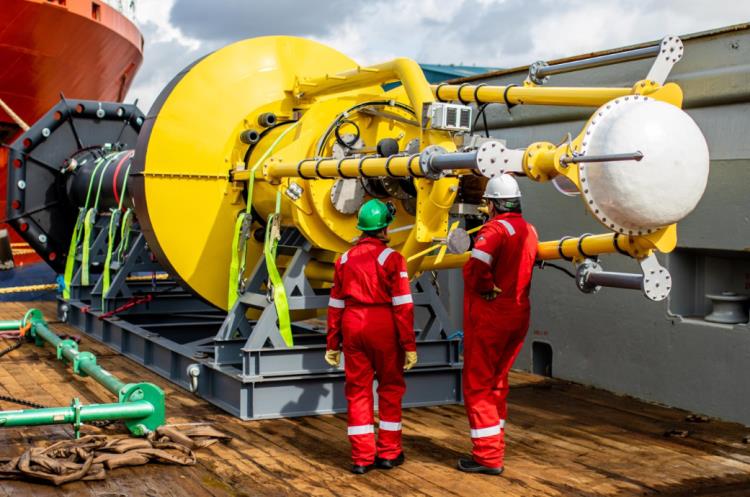
PowerBuoy ready for deployment
Links and Contact Information
- Emissions from Coal plants https://coal.sierraclub.org/the-problem/water-food-supply#:~:text=Coal%2Dfired%20power%20production%20poisons,fish%20that%20swim%%2020in%20them
- How are Ocean Waves Converted into Electricity https://www.energy.gov/eere/articles/how-are-ocean-waves-converted-electricity
- In search of low-cost wave energy https://www.business-standard.com/article/opinion/in-search-of-low-cost-wave-energy-119061600751_1.html
- IUCN on Deep Sea Mining https://www.iucn.org/resources/issues-briefs/deep-sea-mining
- Ocean Power Technologies https://oceanpowertechnologies.com/
- Optimal design of air turbines for oscillating water column wave energy systems: A review https://journals.sagepub.com/doi/pdf/10.1177/1759313117693639
- Renewable Power Generation by Technology (graphs) https://www.iea.org/data-and-statistics/charts/renewable-power-generation-by-technology-historic-and-in-the-net-zero-scenario-2000-2030
- Wave Energy Market Trends https://www.marketsandmarkets.com/Market-Reports/wave-energy-market-217091216.html
Article by: Dr. Katie Conlon, North America 4Revs Program Manager

